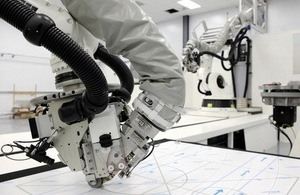Aerospace manufacturing: speeding up winglet production
Winglets - the tips of aeroplane wings that curve upwards - save fuel, reduce noise and make higher rates of climb possible.

Robots working together at the National Composites Centre in Bristol
With demand for winglets growing rapidly GKN Aerospace wanted to speed up production times and reduce costs.
The company worked with 2 High Value Manufacturing Catapult centres, the National Composites Centre (NCC) and the Advanced Manufacturing Research Centre (AMRC) to meet the challenge.
Winglets are made from composite materials to achieve the right combination of shape, strength, weight and durability. However, existing production methods are only partly automated, making assembly labour-intensive and costly.
Redesigning winglets was just one of several collaborative R&D projects funded under the £12 million Structures Technology Maturity (STeM) programme launched by Innovate UK and the research councils in 2012.
Change from the inside out
Each partner worked on a different part of the production process - leading to radical changes in the way winglets are built and assembled:
-
GKN designed a ‘waffle’ sub-structure that could be applied and joined to the upper surface in a single process (co-curing)
-
the NCC’s twin Automatic Fibre Placement (AFP) robots took on the complex task of automating the laying of the complex, double-curvature external ‘skins’
-
the AMRC created an automated cell to assemble the structure - using standard low cost assembly tools including a robotic drilling unit
Robots moving in perfect harmony
One of the key challenges was getting the twin AFP robots to work together in close proximity in a confined space. Ben Hopper of the NCC said:
Our operators had to synchronise the robots’ movements very carefully to manufacture 2 winglets at the same time on the same fixture. But it confirmed what we knew the AFP robots could do and we’ll be applying that knowledge to other projects.
Winglets take flight
The partners were delighted with the results. John Cornforth, GKN’s Head of Airframe Technology for European Special Products said:
Our target was to produce a winglet that performed just the same more quickly and at a lower cost. We achieved 20% cost savings, reduced production times and improved the consistency and quality of manufacturing. We learned a lot that can be applied to other aerostructure projects.
Tom Hitchings NCC Business Development Director added:
The project shows that UK companies, supported by Innovate UK and the resources of the Catapult network, are ahead of the game in delivering the next generation of high-performance, high-quality aircraft components - while reducing manufacturing costs and lead times.
Find out more about the High value Manufacturing Catapult, the NCC and the AMRC